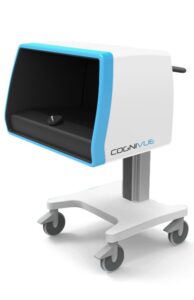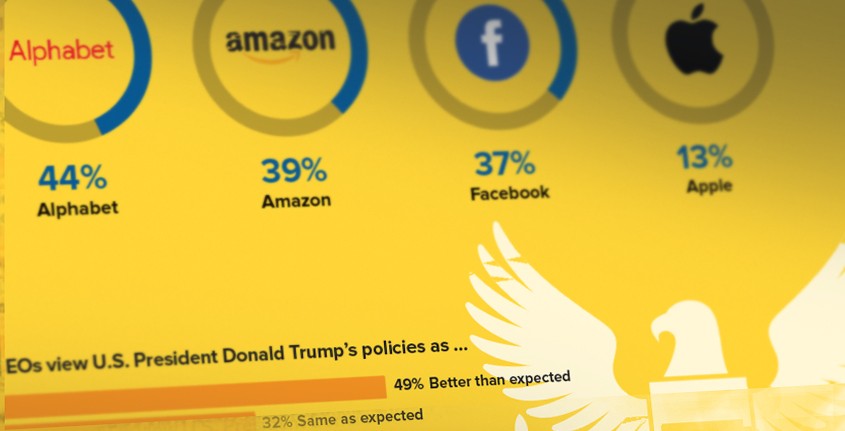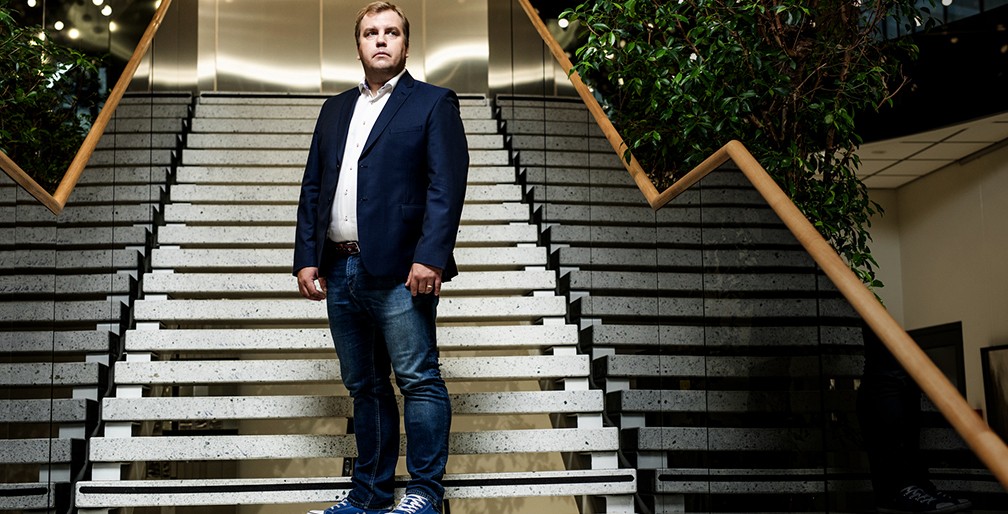Cognivue’s Bold Steps Forward
Changing health care standards requires a herculean effort—this is what Tom O’Neill learned from decades of experience as an executive in the industry. He made this clear to Cerebral Assessment Systems (CAS) board members when they interviewed him in the fall of 2017 to be the company’s CEO.
Mr. O’Neill saw huge potential in CAS, which created a groundbreaking computerized testing device to measure cognitive functioning of patients. Used to detect early signs of dementia and Alzheimer’s disease in patients over 55, the 10-minute test employs adaptive psychophysics to assesses four key domains of the brain: motor function, visual function, perceptual processing and memory testing. The test, called Cognivue®, was the first of its kind to receive approval from the U.S. Food and Drug Administration (FDA). But almost three years after getting FDA approval in 2015, the company’s commercial business had still barely launched.
 Mr. O’Neill could see the profound benefits the test could offer patients, caregivers, physicians and payers. With the U.S. population aging, demand for the product would increase. But after his interview, Mr. O’Neill came to the conclusion that CAS’ board members “didn’t appreciate the time, energy and resources it would take to change the standard of care for cognitive testing.” He turned his attention to other opportunities and in October 2017 accepted a position as president of North American commercial operations at molecular diagnostics provider Qiagen.
Mr. O’Neill could see the profound benefits the test could offer patients, caregivers, physicians and payers. With the U.S. population aging, demand for the product would increase. But after his interview, Mr. O’Neill came to the conclusion that CAS’ board members “didn’t appreciate the time, energy and resources it would take to change the standard of care for cognitive testing.” He turned his attention to other opportunities and in October 2017 accepted a position as president of North American commercial operations at molecular diagnostics provider Qiagen.
Five months after starting at that company, Mr. O’Neill received a phone call from a member of Tom Golisano’s executive team. Mr. Golisano, the billionaire businessman who founded Paychex, had just acquired CAS—now renamed Cognivue, after the test—and he wanted Mr. O’Neill to take the helm. Because Mr. Golisano understood what it takes to build a business from scratch and what it would take to turn Cognivue around, Mr. O’Neill signed on. He became president and CEO in April 2018.
His mission was clear: fix the company’s problems—and unleash its potential. “This wasn’t my first startup or my first turnaround,” says Mr. O’Neill. He had previously worked at SynergEyes, a contact lens maker startup, and spearheaded a successful turnaround at Bausch & Lomb’s North American vision care division, Ortho Clinical Diagnostics North America and Hologic’s Surgical Division. Cognivue was as much of a startup as a turnaround, Share on X he says. Although the company had been founded nearly a decade earlier, its business and marketing strategy needed a breakthrough.
To get there, Mr. O’Neill knew he would have to calibrate his leadership approach to align with his new organizational context. Leading a small startup that is also a turnaround is about being very hands-on and focused, he says. “You wear many hats and play many roles at both the strategic and tactical levels. You have to live and breathe the culture and vision. And you have to be decisive even with limited data and insights,” he says. This last challenge “can be frightening, but it can also be liberating as you leverage the data you have, the experts around you and the decades of experience you bring to the job.”
“The mistake many executives make immediately when they come into a startup is they put all their expensive department heads in place. I learned from SynergEyes that there are big-company people and small-company people, and very few can live in both realms.”
—Tom O’Neill, president and CEO, Cognivue
Three Challenges
Mr. O’Neill identified three main challenges. First, Cognivue’s go-to-market model was not working. The company had been trying to sell its cognitive function device as a piece of capital equipment, charging from $15,000 to $30,000 for it. Yet the device’s target customer base—primary care/internal medicine, neurologists and psychologists—generally could not afford such an expensive piece of capital equipment.
The second challenge involved the device itself. The product’s appearance and marketing were outdated, Mr. O’Neill says. “The device, website, messaging and the logo were all antiquated.” The device attached to a cart with wheels, weighed too much, cost too much to produce and took up too much space in physicians’ typically cramped offices. “It’s a great technology,” Mr. O’Neill says, “but everything about the marketing model was broken.”
Fixing it would require getting the right people onboard—Mr. O’Neill’s third challenge. He had to find people who could thrive in a startup environment. “In a startup, you have to find highly talented individuals who are passionate about working together as a team to drive change in a dynamic environment. They need to be willing to do what it takes to make themselves and the company successful,” he says. Everyone needs to feel that same sense of urgency.
Building a Breakthrough
Correcting the go-to-market model required extensive discussions among the company’s board, Mr. O’Neill and his new team. Mr. O’Neill wanted to try a subscription model requiring customers to sign a contract for an extended period of time. Mr. Golisano demurred, pointing to the company he had founded. “He said, ‘I have 600,000 customers at Paychex, and not one of them is under any long-term contract,’” Mr. O’Neill recalls. “If we provide our customers a great product with great clinical value at a great price, they’ll never leave.” In the end the leadership team decided to provide the Cognivue device through a $325-per-month subscription—without any time requirement. To test the new subscription model, Mr. O’Neill decided to focus his sales team on a few lead markets with aging populations before expanding into more markets.
Improving the device was a far more complicated process. Mr. O’Neill had to first get the right team in place. “I always start with [hiring the right] people because people and culture matter. If you pick the right people who are performance-focused and accountable for what they do and how they do it and you hold them accountable, good things happen.”
He knew from experience that in a startup, the best people are not necessarily the ones with the longest résumés—or the highest salaries.
“The mistake many executives make immediately when they come into a startup is they put all their expensive department heads in place,” he says. “I learned from SynergEyes that there are big-company people and small-company people, and very few can live in both realms.”
To avoid a top-heavy staff, Mr. O’Neill brought in consultants in the fields that Cognivue most needed: R&D, marketing, regulatory, quality, reimbursement and legal. “You get their experience and input but without spending the money on expensive salaries,” he says. “In a startup, you have to spend money like it’s your own.”
When Mr. O’Neill arrived, Cognivue had just four other employees. In his first three months on the job, he made 15 hires. They included 11 sales representatives but only one senior executive.
Rather than a marketing executive, Mr. O’Neill brought on a junior marketing associate. That person conducted market research by visiting the health care providers who already had the device and learning what they did and did not like about it. “It didn’t take thousands of dollars to talk to the customer and validate our go-to-market strategy,” he says. “At a startup, you have to find ways to get as much data and information as you can as inexpensively as you can, and then be decisive.” Share on X
Not all of Mr. O’Neill’s hires have worked out. One employee proved ill-suited for Cognivue’s demanding work and long hours. Rather than waiting to see if performance would improve, Mr. O’Neill acted quickly and let the individual go. “At Cognivue, we fail fast and learn fast,” he says.
In that spirit, Mr. O‘Neill set up weekly agility meetings: 90-minute conference calls with everyone in the organization every Friday morning. “On those calls we talk about what the customer wants/needs, what we learned that week, what mistakes we made and what we can do differently,” he says. “They ensure we are on track—if we are not, we take action to course correct.”
For instance, the Cognivue team learned during the calls that getting access to primary care physicians was proving difficult. These doctors typically see 40 to 60 patients a day and have very little time to speak to sales representatives. So rather than asking physicians to carve out time in their packed schedules, Cognivue decided that its sales reps would aim to meet with their office managers instead. “We make it clear we’re not a pharmaceutical rep with another drug—we’re bringing an innovative solution that allows the physician to be the front line of cognitive care,” Mr. O’Neill says. The office managers then advocated for Cognivue with their bosses, the physicians.
As he assembled a strong team, Mr. O’Neill guided them toward the strategic goal: overhaul the testing device to boost its appeal. “We had to make the device look better while making it Wi-Fi-enabled, smaller and lighter, with an improved user interface. We not only had to make these changes but also reduce the cost of goods sold,” he says.
There was no time to waste, from Mr. O’Neill’s perspective. He initially pushed the team to deliver a new version of the device in July even though he knew their original plan was to launch by December. Cognivue’s director of operations and R&D consultant led the effort, and the team delivered a breakthrough result. The new device began shipping September 1—less than six months after Mr. O’Neill’s arrival. It will improve the device’s appearance and interface, add Wi-Fi connectivity and lower its overall production cost by 40 percent.
Yet Mr. O’Neill calls this version an “incremental improvement.”
The next version, which will come out in Q4 of 2019, will be substantially different, Mr. O’Neill says. Rather than weighing 30 pounds, this iteration will weigh less than 5 pounds. It will also test for more than just general cognitive functioning. It is expected to include new label indications of cognitive impairment: Alzheimer’s disease, dementia, sleep disorders and concussion.
“In a startup, you have to find highly talented individuals who are passionate about working together as a team to drive change in a dynamic environment.”
—Tom O’Neill
Bold Steps Forward
Both new versions of the product represent bold steps forward for Cognivue. Mr. O’Neill says he inspired his team to achieve breakthrough results through four key actions. First, ownership—and not in the theoretical sense. He made every employee an equity owner in the business, and he refers to them as owners. Second, accountability: He ensured employees were accountable to the strategic goal and that they understood how their roles aligned to achieving it. Third, communication through the weekly all-company “agility” calls. Finally, appreciation: He recognized team members for their hard work, input and knowledge, and thanked them often.
Mr. O’Neill knows how much is at stake. “Early screening will drive early intervention and while there is currently no cure for dementia or Alzheimer’s disease, the sooner the doctor can diagnose it the quicker they can put a plan in place that includes diet, exercise and medication to delay the progression of the disease. This is good for the patient, the caregivers, the physicians and the payers,” he says.
“Delivering on that promise requires vision and grit—startups do not become big players otherwise,” says Shideh Sedgh Bina, co-founding partner, Insigniam. Mr. O’Neill knows that from experience, and he is determined to see a bold plan change lives for the better.



